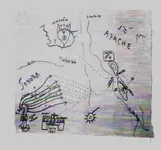Backwoodsbob
Silver Member
- Joined
- Nov 12, 2013
- Messages
- 2,707
- Reaction score
- 1,936
- Golden Thread
- 0
- Primary Interest:
- All Treasure Hunting
I agree with Mike on the knowledge being lost. They did leave stone maps at the location of their stashes. That long March to the coast was in more than one place. There is a strong Jesuit present east of the Mississippi. They knew what was up. They had been expelled twice before. We know they were into all levels of society or ties loyal to them. There is a lot more to their clues than those huge monuments. The whole country is littered with it. I've seen their clues in works of art. It's right in your face but yet unseen. These guys were masters of the consealment. I have a collection of their work. Most is from land I own. I study their work daily. I have shared some with negative reviews. That because most really don't know they work. Well that is as it was done on the eastern half of the country. It's all the same code. Just on a different scale. I need to say I have learned a great deal from you guys and especially the old timers. Mike you once told me that they didn't use small stones. I can prove that theory wrong. But that's not what I'm here to do. I'm not the type who likes to dig in archives. My digging is in the field. My theory on them finding their old stashes is . They lost the technic of the stone. What you guys are use to seeing is only a part of their work. They worked the stones in a way it not easily seen. You don't see the kind of work they did in any modern stone workings. The way they morphed shapes and faces that change with light and angles. Outside the circle of this type of treasure hunting it's all peradolia. That's were most fall short in understanding their work. It's taken me years of learn how it works. It's not something that can be learned from books either. The tablet with the witch. Most of the carvings are clean. The hat has little things not mentioned. Like the duck off the brim. That is one of those hidden features just from the picture. One need to use the light and angle to see if there is other hidden messages. If it's from them it will have something else on it. The method is simple but time consuming. My apologies for jumping in on your debate.
Bob
Sent from my SM-G900T using Tapatalk
Bob
Sent from my SM-G900T using Tapatalk






